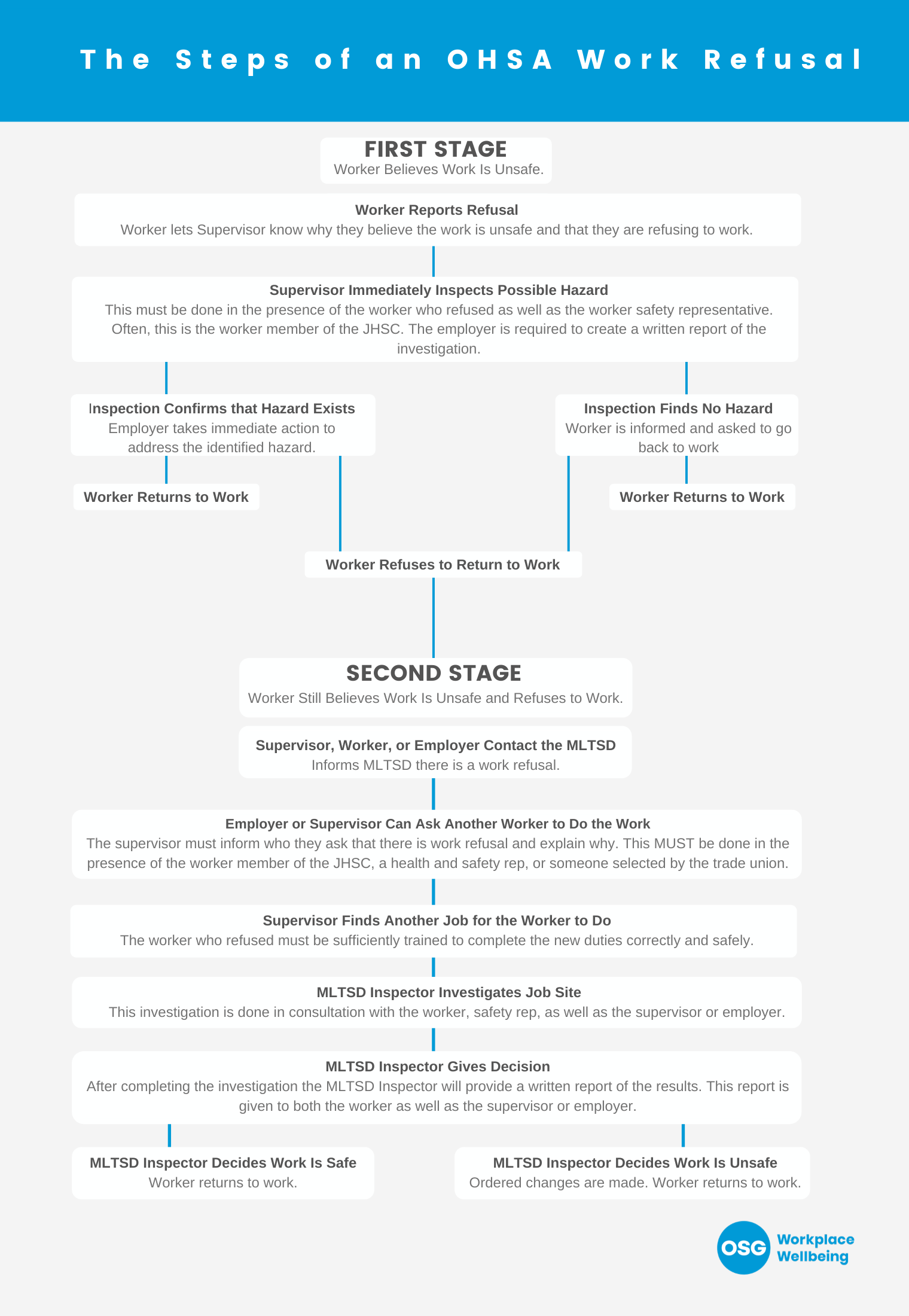Right to know. Right to participate. Right to refuse. The province of Ontario has guaranteed these three basic employee rights since 1979. The Occupational Health and Safety Act (OHSA) outlines the three basic employee rights legally guaranteed to workers. You may have heard of some or all these rights. But do you know what they mean?
It is an employer’s legal responsibility to ensure that their company’s workspace is safe and workers are safe. Simply put, the “right to refuse” means that Ontarians have the right to refuse work they think is unsafe without fear of any reprisal. Unsurprisingly, due to the dangers of COVID-19, the rate of work refusals in Ontario is increasing.
In March 2020, the number of refusals in Ontario doubled compared to February. Concerns about coronavirus were the reason for 85% of March’s refusals. Recently, 11 nurses working in Southwestern Ontario refused to work because of a shortage of masks and respirators—personal protective equipment (PPE) that the Government of Canada has called “essential during the COVID-19 outbreak.” Correctional institutions have also seen COVID-19-related work refusals. As well, at least five construction sites in Ontario have been shut down over Ministry concerns of COVID-related unsafe work conditions.
As an employer, you or one of your colleagues may have already dealt with a work refusal. Or you might want to know what’s involved and prepare before it happens to you. Regardless, as an employer, you need to know what to do and how to handle the situation to protect your workers and your company.
What Is the Right to Refuse?
The right to refuse means that a worker can refuse to do work they have reason to believe is unsafe. Although the language, process, and details may differ from province to province and territory to territory, the right to refuse is a right that all Canadians have. Refusing to work is a serious action that the Government of Canada stresses “should not be done lightly or as a routine method of solving workplace problems.”
Are There Any Workers Who Do Not Have the Right to Refuse?
There are professions that have a limited right to refuse depending on the circumstances. In general, this applies to professions where there is an inherent risk or danger because of the nature of the work or where the work takes place. In these cases, a worker may not refuse work if a “stoppage would directly endanger the life, health or safety of another person.” Some of the professions that are exempt:
- Police officers
- Firefighters
- Correctional officers
As well, if you work in the following workplaces you also have a limited right to refuse:
- Hospitals
- Long-term care homes
- Rehab centres
- Behavioural or mental health centres
- Correctional institutions
- Residential group homes for people with mental or developmental disabilities
- Crown laboratories
Importantly, this also includes people who work at the above workplaces in “laundry, food services, power plant, or technical service” roles.
When Can a Worker Refuse to Work?
A worker can only refuse work when he or she has reason to believe that the work is dangerous and unsafe. This means that they cannot refuse work because they don’t feel like doing it or would prefer a different task. It only applies to unsafe work. The Canada Labour Code defines a danger as:
“any hazard, condition or activity that could reasonably be expected to be an imminent or serious threat to the life or health of a person exposed to it before the hazard or condition can be corrected or the activity altered.”
As well, each jurisdiction or province within Canada has their own laws. For example, in Ontario the exact language the OHSA, often referred to as the Green Book, uses is as follows:
V.43.3 A worker can refuse to work if he or she has reason to believe that:
(a) any equipment, machine, device or thing the worker is to use or operate is likely to endanger himself, herself or another worker;
(b) the physical condition of the workplace or the part thereof in which he or she works or is to work is likely to endanger himself or herself
(b.1) workplace violence is likely to endanger himself or herself; or
(c) any equipment, machine, device or thing he or she is to use or operate or the physical condition of the workplace or the part thereof in which he or she works or is to work is in contravention of this Act or the regulations and such contravention is likely to endanger himself, herself or another worker
Are There any Punitive Actions You Can Take Against a Worker Who Refuses to Work? What If the Work Was Later Found to Be Safe?
No, an employer, supervisor, or company cannot take any punitive action or even threaten to take action against a worker who refuses to work. This includes any action up to and including firing a worker. This also applies if the work was later determined to be safe. From the Act:
VI.50.1 No Employer or person acting on behalf of an employer shall,
Dismiss or threaten to dismiss a worker;
Discipline or suspend or threaten to discipline or suspend a worker;
Impose any penalty upon a worker; or
Intimidate or coerce a worker
However, an employer can take disciplinary action against an employee if a Ministry of Labour, Training, and Skills Development (MLTSD) inspector finds that the worker who refused to work “willfully abused his [or her] right to refuse dangerous work.”
Where Can I See The Exact Language of the Right to Refuse?
Each jurisdiction of Canada has similar steps that are required for both employers and workers. It is important that you understand exactly what’s involved where you are located.
For example, the section of Ontario’s OHSA that specifically addresses the right to refuse can be found in Part 5. Part 6 covers any possible reprisal or threat by an employer. If you are looking for a copy of the OHSA, often referred to as the Green Book, which all employers in Ontario are legally required to display and make available in their workplace, you can get OSG’s that contains the complete and current OHSA and is easy to navigate.
Looking for a jurisdiction other than Ontario? Here is a list of provincial government sites addressing the right to refuse:
- Alberta
- British Columbia
- Manitoba
- Newfoundland and Labrador
- New Brunswick
- Northwest Territories and Nunavut
- Nova Scotia
- Ontario
- Prince Edward Island
- Saskatchewan
What Should an Employer or Supervisor Do When a Worker Refuses to Work?
The first step is to make sure that you or your supervisor is aware of what’s involved in every stage of a work refusal. Remember to keep accurate written records of the entire process. The right to refuse is guaranteed across Canada and you must take the steps outlined in your province or jurisdiction. In the answer to the next question, you can read the steps required in Ontario.
What Happens During a Work Refusal in Ontario?
The OHSA outlines in detail the steps involved when a worker refuses to work. As an employer, it is your responsibility to adhere to the OHSA and follow these steps. As well, you are required to keep written documentation of every work refusal.
There are two stages to a work refusal.
The first stage happens when a worker informs their employer or supervisor that they are refusing to work because they believe it is unsafe to proceed. It is then the supervisor’s and/or the employer’s duty to immediately perform an inspection and determine what hazards may exist.
Importantly, the inspection needs to happen in the presence of the worker in question and, if they exist, a committee member representing the workers, or a health and safety representative, or a worker who because of knowledge or experience and training is selected by a trade union representing the workers.
If the investigation determines that the work is, in fact, unsafe, the employer must take immediate action to make the work safe. After the identified hazards are remedied, the worker returns to work.
If the investigation concludes that the work is unsafe and the worker still refuses to work then the process moves to the second stage.
The second stage of a work refusal means involving the Ministry of Labour, Training, and Skills Development (MLTSD). It is the responsibility of either the employer, supervisor, or safety representative to contact the ministry and let them know there is a work refusal. During the investigation, the supervisor should find alternative work for the worker to do.
An MLTSD inspector will come to the worksite to conduct an investigation to determine if the work is safe or unsafe.
While the investigation is underway, you or a supervisor may ask another worker to do the refused work. If you choose to ask someone else, you must let them know that there is a work refusal and explain why. This must be done in the presence of a safety representative for the worker.
If the MLTSD inspector determines the work is safe, the worker is “no longer entitled to refuse to work.”
If the MLTSD inspector determines that the work is unsafe and a danger exists, he or she will issue directions to the employer of the changes or actions required. Typically, this involves orders to “remedy the hazard.” While the changes are being implemented, the worker may continue to refuse the dangerous work.
This flowchart outlines the steps that are required according to the Act. Looking for a downloadable version? Download a free, high-resolution PDF at the bottom of this article.

Do I Have to Pay a Worker That Has Refused to Work?
During the refusal process, you are required to pay your worker at least their regular rate of pay.
Are There Any Circumstances Where an MLTSD Inspector Will not Investigate a Right to Refuse stoppage?
Yes, there are three circumstances where an MLTSD Inspector will not conduct an investigation.
An inspector may choose not to investigate if he or she thinks that:
- It is more appropriate to deal with the stoppage using procedures outlined in Part I or III of OHSA or another “Act of Parliament”
- The claim is “trivial, frivolous, or vexatious”
- The worker who is refusing to work is doing so “in bad faith”
If the employee who refused to work still thinks they have grounds to refuse work, they have 30 days to file an application for a Federal Court to review the case.
Can a Worker Appeal an MLTSD Inspector’s Decision?
Yes, the worker has ten days to appeal the decision if the inspector determines that the work is safe and orders the worker to return to work. They can appeal in writing with an MLTSD appeals officer.
What Should I Do With the Worker During a Work Refusal?
Generally, you or your supervisor should find alternate duties or tasks that the worker can perform until the situation is resolved.
Can a Worker Refuse to Work if They Are Afraid of Contracting COVID-19?
This is a complicated question and depends on the specific situation. Keep in mind, for all instances the MLTSD already evaluates the individual circumstance of every work refusal they are called to investigate.
As well, the COVID-19 pandemic is an emerging situation with workers in a variety of industries refusing to work. It is too early to provide a clear answer on how the MLTSD or provincial or federal bodies will rule on these cases. Finally, as health care professionals learn more about how novel coronavirus is transmitted, what is considered unsafe may also change.
If you are looking for advice specific to your particular workplace, please contact us at info@osg.ca or toll-free at 1-800-815-9980.
Please fill out this form to download our free, print-quality OHSA Work Refusal Flowchart.

